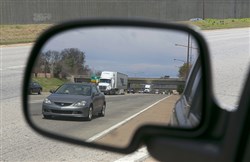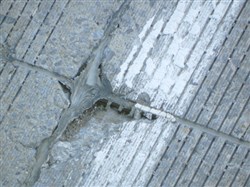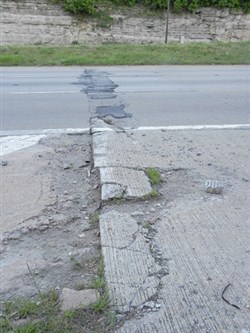VOL. 40 | NO. 15 | Friday, April 8, 2016
I-440: An $8 million ‘cheap fix’ gone bad
By Hollie Deese
Author and photographer Jerry Park clocked many miles crossing the state in his Ford Flex while working on his book Slow Roads Tennessee: A Photographic Journey Down Timeless Byways.
Some roads were good, filled with charm and beauty. Others, not so much. But no matter how old or unmaintained the road, Park never found one worse to drive on than the bypass near his own Richland neighborhood – I-440.
“It’s the worst road I know of,” Park says. “I do a lot of landscape photography and go all over the United States to do it and so I’m around an awful lot of roads. And it is the worst.
“So many people drive it at least twice a day, too, so they’re mad when they get to work and they’re mad when they get home.”
Neighboring resident Mike Haney, a mechanical engineer who travels outside of the city frequently for work, agrees with that sentiment.
“I think it’s one of the worst roads in the state,” Haney notes. “Maybe 40 in Memphis at one spot is equivalent, but they’re doing construction there.
Anyone who has driven on I-440, which runs roughly seven miles south of downtown from I-40 on the west side to I-24 on the east, knows what they are talking about.
The difference between that road – which handles about 100,000 per day – and any other in Tennessee is immediately apparent.
That’s thanks to the grooved texture that was part of a 2009 rehabilitation project to improve safety conditions and help preserve the aging concrete that was already past its prime.
“Over time that concrete just, for the amount of traffic that was travelling on it, got polished,” says BJ Doughty, Tennessee Department of Transportation’s director of community relations and communications.
“It became slicker. This was providing a texture so that the tires had something to grip a little bit more. Because of the age of that roadway and the condition of that concrete overall, we were seeing some hydroplaning issues. The grooving was an attempt at improving those conditions when we couldn’t come in and replace the entire roadway.”

Ride along on a video tour of I-440's worst section, I-40 to 21st Avenue, with the Ledger.
That grooving and texture in the $8 million dollar rehabilitation project (almost double its initial $4.3 million estimate) is called diamond grinding, a pavement preservation technique that removes surface irregularities, as well as filling some joints in the concrete pavement.
“Modern pavements have a texture to them that is grooved,” says Paul Degges TDOT Chief Engineer.
“What we did on 440 in 2009, we went in and actually used a saw and cut grooves that are parallel to traffic flow. We worked with the concrete industry to try to find some ways to improve the skidability on the roads.
“We did some texturing work and then put those grooves in it to help bleed the water out.”
As Assistant Director of Construction for TDOT, Jay Norris is an asphalt and concrete specialist who says the grooving was meant to act as miniature gutters to assist with the draining of water from the roadway as well as smooth the surface following the substantial concrete repair project.
“They give the water somewhere to be that’s not kissing that tire on that road. It helps mitigate hydroplane,” Norris says.
“Safety is very important to us. The durability of our pavement is very important to us. We took this economic approach. It was cheap, but it addressed texture, it stopped hydroplaning and there were possible noise mitigation benefits from it.
“For a cheap fix it was really a three-win situation.”
A 2012 article that ran in the Pavement Preservation Journal details the rehabilitation process TDOT chose, called concrete pavement preservation with full-slab replacement.
Less expensive than pricey asphalt overlays, big slabs of concrete were replaced and the 350,000-square feet of diamond grinding and grooving done afterward was meant to require no further maintenance for 12-15 years post completion.
But it doesn’t seem that what was promised actually worked out that way.
“There were very few roads built in Tennessee during that vintage that were concrete,” Degges says. “The earlier concrete that was built in the 60’s and 70s has all been pulled up and either replaced with concrete or asphalt. The stuff that was built after that, we haven’t had to do anything yet.

About 100,000 cars a day test I-440’s obsolete concrete roadway. Grooves were cut into the surface in 2009 when it was already two years past its lifespan. The “cheap fix” has not been successful.
-- Michelle Morrow | The Ledger“Truth be told, I’m not completely satisfied with the end result that we got out of that project. Obviously, a lot of people aren’t real happy with it. It’s just not something that we’re real, real pleased about.”
Doughty says even though they had hoped to see some life-extension of the road the reality is 440 was already nearing the end of its use, and cost was a big factor in choosing this option to begin with.
“When it comes down to economics, we don’t have the money to do everything we’d like to do,” she says.
‘Pot-holed to pieces’
Councilwoman Kathleen Murphy, District 24, says in an email she has only had one person complain to her about potholes on I-440, but Haney, who drives it every day, says they are jarring to say the least.
“At first when they put the grooves in, your car would sway back and forth,” Haney adds. “My kids thought that was neat, fun. Now it is just so rough I think it’s bad for our cars. It’s probably pretty dangerous too because sometimes you hit those potholes and it jerks your car around.”
Drivers have nothing to worry about when it comes to the texture, Doughty says, though some motorists did contact them shortly after the grooving was performed to says it felt “strange.”
Degees says research done before the project began indicated drivers would experience a sensation from the grooves – more pronounced in smaller cars - but there would be no impact on safety.
“I was hoping to get a product that would last a whole lot longer,” Degges adds. “Truth be told, I think if you look at 440 now it’s potholed to pieces.
“We worked with the industry to try to come up with a state-of-the-art solution, and I’m just not real satisfied that we got our money’s worth out of it. I don’t think that I will use that tool to refurbish a concrete pavement anywhere. I’m not satisfied with how it worked out.”

The concrete surface of I-440 seems to deteriorate fastest where slabs intersect. This intersection, beneath the Long Boulevard overpass near Centennial Park, will likely soon be patched with asphalt.
-- Lyle Graves | The LedgerOne possible reason Haney thinks the road is crumbling sooner than anticipated is the series of harsh winters that have hit the south in recent years. Low temperatures means water running through the grooves has a chance to freeze and do some damage to the material.
“Water gets in these grooves and gets in the cracks and expands and busts up the concrete and that’s what causes potholes,” Haney explains.
“I think you can definitely see it after every winter or right after a big freeze. The potholes are much worse. It’s a real mess. It’s a shame that they’ve spent that money and now it’s, basically, it’s made it worse.”
Degges doesn’t disagree.
“Bad winters are bad on our roads,” Degges notes. “Water is the enemy of all pavements. If it’s not causing problems on the surface the water gets down in the base material and creates soft spots. Water is one of those materials that expands when frozen as opposed to contracts.”
The other reason the rehabilitation is not holding up is just the sheer number of people driving on the road. Park moved to Nashville from Atlanta 30 years ago and compares what is happening with Music City traffic now thanks to all the infill development to what was happening there then.
“A lot of people like to live over here and so as soon as a house goes down they put three more skinny houses in its place,” Park says. “Welch College just sold and they are going to put, I think, 80 total residences just on that little bitty footprint. That’s probably an average of 250 people and many cars. Yeah, it’s definitely worse than it used to be.”
Welch College was located on seven acres at 3606 West End Avenue and sold to Mike Ford Custom Builders of Franklin for $11.25 million last summer.
At the time of the sale, Ford announced his company would be planning 21 single-family luxury homes on Richland Avenue and 30 brownstones fronting West End Avenue.

Grooved concrete crumbles alongside patchwork asphalt repairs at the Murphy Road on ramp to I-440.
-- Lyle Graves | The LedgerThe grooved texture was also meant to reduce noise through the surrounding neighborhoods, but Haney says the only time it gets quiet is when cars are at pretty much a standstill – the only benefit of the increased traffic in the area.
“If I open up my window I can hear 440 and it probably made it worse,” he says of the grooves. “It’s hard to says if it’s louder because there’s more traffic. You definitely can tell in rush hour when there’s no movement. It’s actually a lot quieter here.”
History of 440
Degges’ relationship with 440 is a long and sometimes emotional one. As the inspector of the plant that built all of the sound walls between I-65 and I-40 West, he scratched his initials in the top of most of them as his inspection mark.
“I cut my teeth on construction projects and that was one of them,” Degges says of 440.
His father was also a civil engineer who worked for the Federal Highway Administration.
“When your father’s an engineer, you don’t take vacations. You take field trips,” Degges adds. “I’ve been hearing the story of 440 for a long time.”
His family moved to Nashville in 1969 when Degges says 440 was in the midst of a big lawsuit because 440 was designed and right-of-way purchased for a different product than was actually built.
“We actually bought the right of way for an interchange at Granny White Pike that was never built,” Degges explains.
“It was going to be basically up in the air at grade, but we ended up depressing the road so it would have a lesser impact on communities. That’s why it’s in a cut in most places and you see those rock bluffs everywhere.”
TDOT eventually won the lawsuits by showing the project was in the public interest.
“The Interstate Program started in 1956 and through the 1960’s there were communities across the country where interstates just plowed through neighborhoods and so people started getting upset,” Degges says. “We tried to come up with a project that was a compromise.”
Construction finally started in the late 70s, and I-440 finally opened to the traveling public in 1987.
What’s next for 440
While the potholes are a problem, what drivers should really be worried about is what happens next for the aging interstate that has already lived far past its prime.
Norris says there are still some safety issues on I-440, including median crossover accidents, and a $6.1 billion dollar backlog of state road projects doesn’t even include the bypass.
The concrete Degges says was initially designed to last about 20 years is now 29 years old.
There have been a few substantial concrete slab replacement projects over the last decade, and grooving helped extend the life of the concrete. But now the entire roadway is in need of a complete rehabilitation.
A project is currently in the development phase, but the many things have to happen before it moves forward, including determining what is financially feasible.
A project with all the bells and whistles would include adding through-lanes where there are currently drop offs as well as addressing median and lighting issues.
“If I want to come in there and try to solve all of the problems, it might be at $100 million dollar project, and finding $100 million dollars right now is a very difficult thing to do,” Degges says. “When you ask for everything, you get sticker shock.”
Another option would be to spend considerably less, around $30-$40 million, for a scaled-back pavement project with some safety improvements.
But Degges knows the public is going to expect some big changes with the kind of disruption any roadwork on I-440 would present.
“You hate to put the public through a difficult construction project and then, when the project is done, they say, ‘Well, the pavement’s smooth, but this is what I had before,’” he explains.
“We want to try to find ways to do incremental improvements that address not only the condition, but that can impact congestion and safety.”
One of the biggest cost factors will be determining which material to use, concrete or asphalt. Degges says there is a tradeoff that will take a lifecycle cost analysis to determine which is best when it comes to 440’s rehab.
Asphalt is cheaper in the short-term, but concrete lasts longer.
Asphalt also is easier to repair but it must be repaired more often.
“There are trade-offs between the two, and we use both of them in different places, but one of the issues with concrete is when it gets to the end of its useful life I can’t just take a milling machine and mill it up,” Degges explains.
“With an asphalt road, like you see in a lot of places around, we’d send a milling machine out, mill it and just repave it, but that surface doesn’t last as long as concrete. Ultimately we might bid the two head to head.”
TDOT also will need to come up with a solid plan for moving the number of cars that travel I-440 every day. When the repair work was done in 2009, only a quadrant of 440 would close at a time on weekends, and the hope is something similar could be done again.
“One of the things that the business community tells us is from an economic impact standpoint, if you can get in and get out in a hurry, it has such a huge benefit,” Degges adds.
One thing that will definitely not happen is an interchange at Granny White Pike, despite local rumors related to that initial proposal placement of 440. “We have no plans to do that,” Degges says.
The problem with getting things moving on any improvement at all though, is finding the money for it.
“Since we are in the midst of some discussions about how transportation is funded in Tennessee, I am asking my staff to explore the more in-depth project that I think will better serve the growth in Nashville, but I also have to keep in mind I’m going to be at a point in the next two years or so where I’m going to have to do something about the pavement,” he says.
Because of current spending issues when it comes to transportation Degges is in a planning holding pattern.
“Do I just go ahead and pull the trigger and fix the pavement or if I wait just a little bit, there might be an opportunity for us to do a project that the benefits are much larger than just fixing the pavement?” he says.
“It doesn’t make a whole lot of sense for me to finalize a set of design plans for a very, very expensive project if I don’t have the money to do it.”
Still, as bad as 440 is Park shudders to think of the alternative.
“It’s not going to go away, and it’s not going to get better,” Park says. “But try to imagine life without it.”